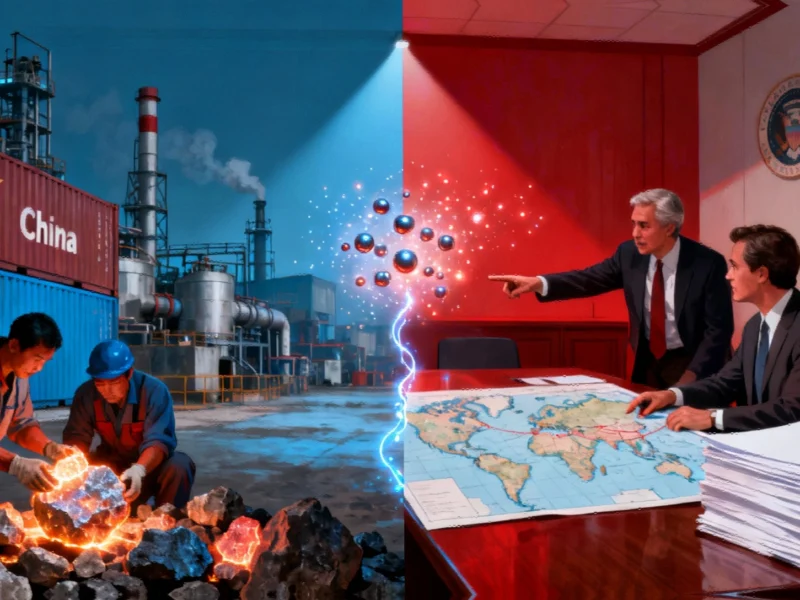Strategic Minerals Become Geopolitical Leverage
In a move that has sent shockwaves through international markets, China’s Ministry of Commerce has implemented sweeping new regulations governing rare earth exports through Announcement No. 62 of 2025. This strategic maneuver comes at a critical juncture in U.S.-China relations, effectively ending months of tariff truce and demonstrating Beijing’s willingness to weaponize its dominant position in the global supply chain for critical minerals. The timing of these restrictions, as detailed in this comprehensive analysis of China’s export control escalation, appears calculated to maximize pressure ahead of anticipated high-level negotiations between the world’s two largest economies.
The new framework represents a significant tightening of China’s grip on rare earth elements—seventeen metals crucial for manufacturing everything from consumer electronics to advanced weapons systems. Under the revised regulations, foreign companies must now obtain explicit government approval for exporting any products containing even minimal quantities of rare earths, while simultaneously declaring the intended end-use applications. This level of oversight grants Chinese authorities unprecedented visibility and control over how these critical materials flow through global supply chains.
Immediate Global Repercussions
The announcement triggered an immediate and forceful response from the Trump administration, with the U.S. President threatening to impose additional 100% tariffs on Chinese goods while considering countermeasures involving export controls on essential software platforms. U.S. Treasury Secretary Scott Bessent characterized the situation in stark terms: “This is China versus the world. They have pointed a bazooka at the supply chains and the industrial base of the entire free world, and we’re not going to have it.”
Chinese officials have pushed back against this characterization, with a commerce ministry spokesperson stating that the U.S. had “deliberately provoked unnecessary misunderstanding and panic” regarding the restrictions. The spokesperson emphasized that “provided the export licence applications are compliant and intended for civilian use, they will be approved,” suggesting a more nuanced approach than initial reactions might indicate. This diplomatic tension mirrors recent cybersecurity challenges facing global technology infrastructure, where geopolitical tensions increasingly manifest in economic and digital domains simultaneously.
Broader Economic Warfare Escalation
The rare earth confrontation has rapidly expanded into additional economic fronts, with both nations implementing reciprocal port fees on each other’s shipping vessels this week. This tit-for-tat escalation marks the end of a period of relative calm that followed the May truce brokered by senior U.S. and Chinese officials. The timing is particularly significant given the expected meeting between President Trump and China’s President Xi Jinping later this month, where experts believe China’s rare earth advantage will provide substantial negotiating leverage.
According to international business lecturer Naoise McDonagh from Australia’s Edith Cowan University, China’s new controls are bound to “shock the system” by targeting specific vulnerabilities in American supply chains. “The timing has really upset the kind of timeline for negotiations that the Americans wanted,” McDonagh observed, highlighting the strategic calculation behind Beijing’s move. This development occurs alongside other significant energy policy decisions affecting global markets, creating a complex web of interconnected economic pressures.
China’s Rare Earth Dominance
China’s position in the rare earth market represents a classic case of strategic advantage developed over decades. While other countries possess rare earth deposits, China controls approximately 90% of global refining capacity and processing capabilities. This near-monopoly enables Beijing to influence production timelines, pricing structures, and technological development across multiple industries simultaneously. The country’s dominance extends beyond simple extraction to include sophisticated separation technologies and manufacturing expertise that would take competitors years to replicate at scale.
The strategic importance of rare earth elements cannot be overstated. They are essential components in permanent magnets that power everything from electric vehicles and wind turbines to precision-guided munitions and fighter aircraft. Modern computing, telecommunications, and renewable energy infrastructure all depend on reliable access to these materials. This dependency creates what analysts describe as a “strategic chokehold” that China can tighten or loosen according to its geopolitical objectives. The situation parallels developments in the artificial intelligence sector where strategic partnerships are reshaping competitive landscapes, though with potentially more immediate consequences for global manufacturing.
Future Implications and Industry Response
The immediate industry response has been one of contingency planning and supply chain reassessment. Manufacturers dependent on rare earth inputs are exploring alternative sourcing options, though viable short-term alternatives remain limited. The development of rare earth projects outside China has accelerated, but these initiatives face significant technical, environmental, and economic hurdles before they can meaningfully challenge China’s dominance.
Longer-term implications suggest a fundamental restructuring of global supply chains for critical materials. Nations and corporations are likely to increase investments in recycling technologies, material substitution research, and strategic stockpiling to mitigate future supply disruptions. The current confrontation may ultimately accelerate technological innovation in materials science while reinforcing trends toward supply chain regionalization and redundancy. However, in the immediate term, China’s move has successfully demonstrated that control over critical minerals represents a formidable tool in twenty-first-century economic statecraft—one that other resource-rich nations are undoubtedly studying closely as they formulate their own strategic responses to an increasingly fragmented global trading system.
Based on reporting by {‘uri’: ‘bbc.com’, ‘dataType’: ‘news’, ‘title’: ‘BBC’, ‘description’: “News, features and analysis from the World’s newsroom. Breaking news, follow @BBCBreaking. UK news, @BBCNews. Latest sports news @BBCSport”, ‘location’: {‘type’: ‘place’, ‘geoNamesId’: ‘2643743’, ‘label’: {‘eng’: ‘London’}, ‘population’: 7556900, ‘lat’: 51.50853, ‘long’: -0.12574, ‘country’: {‘type’: ‘country’, ‘geoNamesId’: ‘2635167’, ‘label’: {‘eng’: ‘United Kingdom’}, ‘population’: 62348447, ‘lat’: 54.75844, ‘long’: -2.69531, ‘area’: 244820, ‘continent’: ‘Europe’}}, ‘locationValidated’: False, ‘ranking’: {‘importanceRank’: 8548, ‘alexaGlobalRank’: 110, ‘alexaCountryRank’: 86}}. This article aggregates information from publicly available sources. All trademarks and copyrights belong to their respective owners.



